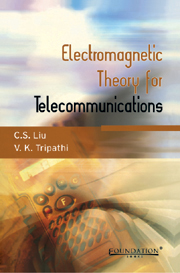Book contents
- Frontmatter
- Contents
- Preface
- 1 Electromagnetic Fields
- 2 Plane Waves
- 3 Guided Waves
- 4 Radiation
- 5 Radio Communication and Radar
- 6 Satellite Communication
- 7 Laser and Optical Fibre Communication
- 8 Geological Seisming and Remote Sensing
- 9 Relativistic Covariance of Electrodynamics
- 10 Radiation from Accelerated Charges
- Appendix A
- Appendix B
- Index
Preface
Published online by Cambridge University Press: 26 October 2011
- Frontmatter
- Contents
- Preface
- 1 Electromagnetic Fields
- 2 Plane Waves
- 3 Guided Waves
- 4 Radiation
- 5 Radio Communication and Radar
- 6 Satellite Communication
- 7 Laser and Optical Fibre Communication
- 8 Geological Seisming and Remote Sensing
- 9 Relativistic Covariance of Electrodynamics
- 10 Radiation from Accelerated Charges
- Appendix A
- Appendix B
- Index
Summary
Telecommunication has become an increasingly popular means of communication, enabling the rapid processes of globalisation. People are easily ‘connected’ through cell phones and the Internet, even though they are in different continents and thousands of kilometres apart. Today there are an estimated 1.3 billion people using the Internet daily, emailing, Googling, purchasing books on Amazon.com or buying merchandise on eBay.
The widespread use of means of telecommunication has been rendered possible by the rapid progress of the underlying science and technology, as well as the speedy development of requisite software and hardware. Discovery of electromagnetic waves has been the most important and fundamental breakthrough, initiating a revolution in the world of telecommunication. It all started with the discovery of laws of electromagnetic induction by Faraday in 1831. Soon after, in the 1850s, Maxwell wrote his masterful treatise on electromagnetic theory, culminating in the discovery of Maxwell's equations. Finally in 1887, Hertz experimentally observed the propagation of an electromagnetic wave emitted by an oscillatory dipole in free space. He said in 1989, ‘Electricity has become a mighty kingdom. We perceive it in a thousand places where we had no proof of its existence before. The domain of electricity extends over the whole of nature’ Indeed in 1895, Marconi succeeded in transmitting the Hertzian wave over half a mile, eventually not only over the British channel (1897) but across the Atlantic ocean (1908), heralding us into the age of telegraph and wireless communication.
Electromagnetism, thus, has had profound effects on our lives and and has become an integral part of our global existence.
- Type
- Chapter
- Information
- Electromagnetic Theory for Telecommunications , pp. vii - viiiPublisher: Foundation BooksPrint publication year: 2007

